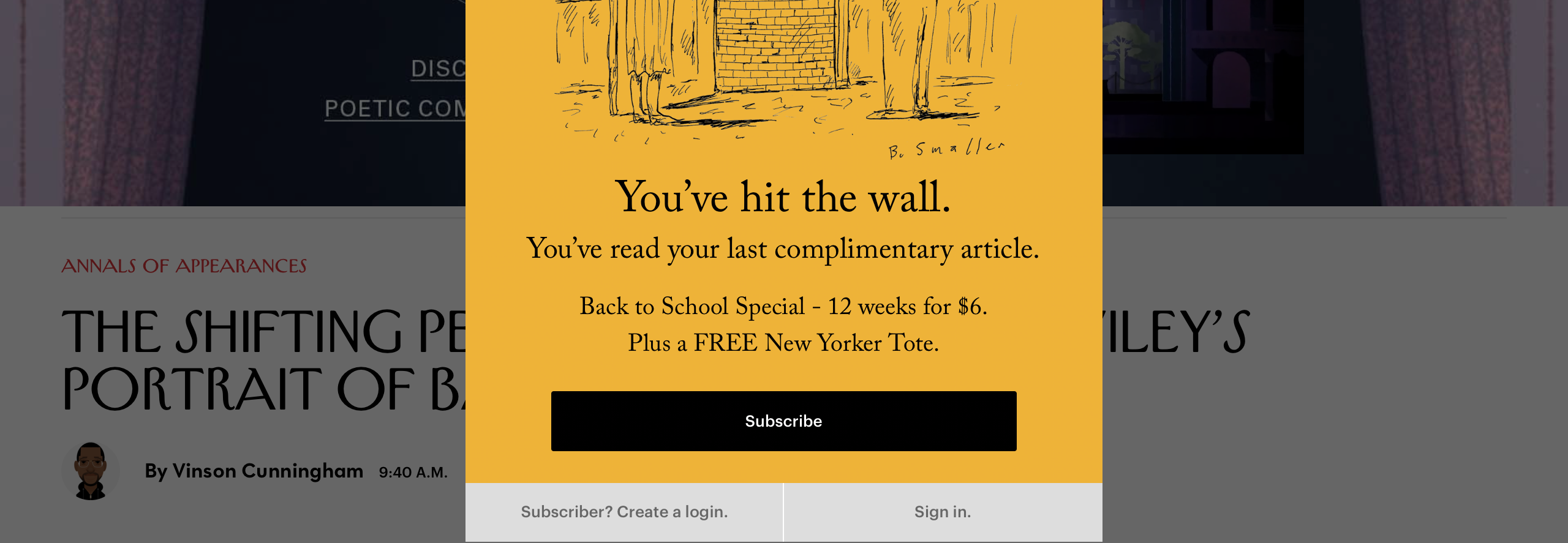
Reinventing the paywall
More engaging and customized subscription offers can turn readers into paying customers.
News organizations have seen a spike in digital subscriptions, but traditionally paywalls have repelled more than engaged readers. Whether the paywalls were hard or metered, the problems were the same: How to set the right price for the product, and how to avoid alienating readers and convert them into paying customers?
A number of companies have set out to deal with these questions and have come up with various innovative approaches, best described by what news industry analyst Ken Doctor calls “Paywalls 2.0,” a catch-all term for new ways of monetizing digital content.
While Paywalls 1.0 are binary (they differentiate only between subscribers and non-subscribers), are hosted on the news organization’s website, and demand that users pay a fixed price to access content, Paywalls 2.0 challenge the conventional restrictions, creating a more dynamic meter and various opportunities to generate revenue. Three main trends have emerged.
- Non-binary paywalls
For years, paywalls were simple: Whoever paid the money could access the content, and everyone else was left out (except for those using the backdoor of social media or skirting past the meter with ”incognito” or “private” browsing). Now publishers have discovered that subscriptions are only one way to get money from users. What if, for example, users could agree to watch an ad before reading an article? What if they could pay for a newsletter instead of subscribing to the whole product?
A good place to consider the results of this type of thinking is Piano, one of the largest companies specializing in tools to customize paywalls. Piano’s tool Composer targets specific user groups with special offers and messaging. Instead of offering a simple subscription, publishers can ask users to whitelist their website in ad blockers, sign up for a newsletter, buy a ticket to an event, or create an account on the site. These offers provide ways to either bolster other sources of revenue (through higher ad views or ticket sales) or to make readers more engaged with the product, perhaps leading them to subscribe at a later time. Ideally, the offers are tailored to the profile of the user (“Hey, we notice you really like our cycling coverage—check out our premium Tour de France product”).
A new player in this field, Invisibly, is a project by Square co-founder Jim McKelvey. Media analyst Ken Doctor says the startup has been “the news industry’s best-kept secret,” though “hundreds” of media outlets have already signed up to test the product. Invisibly will offer readers more choices to access an article—via payment per article, day passes, week passes, watching an ad, or answering a survey. An “invisible wallet” will keep track of user engagement, the ad-messages received, and the money spent on content, triggering offer messages at optimal times. The service is supposed to work across different participating news sites. While Invisibly resembles a micropayments company, Doctor says, “it believes that a newer kind of advertising engagement will generate most of its revenue.”
- Netflix for news
Most people read more than one news source a day, so in the age of paywalls they might have to subscribe to multiple publications—several different websites, several different prices, several different transactions. But what if they could get articles from all of their favorite news sources in one place and behind one paywall? Though companies like Beacon and Magzter have tried it, the idea of Netflix-style aggregation has seen a revival.
One of the best-known examples is the Dutch startup Blendle, which began beta testing in the U.S. (but has still not officially launched). It offers access to articles from The New York Times, The Economist, Time Magazine, and others on a pay-per-article basis. Other services like Medium and Scribd give users all-you-can-read access to selected articles from several news sources for a monthly fee ($5 for Medium, $8.99 for Scribd). Australian startup Inkl offers both pay-per-article and all-you-can-read plans.
- Pay what you want
Any price that a news organization sets will come with two disadvantages: People who think the price is too high are not going to subscribe, and those who would have been willing to pay more will end up paying less for their subscriptions.
PressPatron, a service from New Zealand founded by Alex Clark, is letting users decide how much they would like to pay for journalism. Users can choose whether they want to make a one-time or a monthly contribution to gain access to several news sites in Australia and New Zealand. As of last summer, the average one-time contribution was 46.90 New Zealand dollars (about $34.30 U.S.), and the average monthly contribution was NZ$11.40, Nieman Lab reported.
Unique approaches
Some other projects have found different approaches to content monetization.
Given that more than 11 percent of global users are blocking ads on the web, Scroll—a project started by Chartbeat founder Tony Haile—plans to offer these people what they want: An ad-free experience over multiple news sites and multiple platforms for a monthly fee of $5. Scroll will divide the fee among the news organizations that participate in turning off ads for users.
Laterpay, a company from Germany, promotes a concept often referred to as “the digital bar tab.” When users read a premium article, it will add the price of that article to a running tab. Readers only have to settle their tabs after they reach a certain threshold (in the case of Spiegel Online, one of the first adopters of Laterpay, the amount was 5 Euros). Laterpay gives users a taste of the product they are buying without giving it away for free.
The paywall of the future
There is no way of telling which of these approaches to monetizing content will prevail in the future, but clearly more publishers are gravitating to more customized paywalls.
Key quotes
If you ask readers, do they want to access content for free, or do they want to buy a subscription, then, no surprise, a big amount say they want that content for free. There’s even a German word for the ‘no cost’ mentality: Kostenlosmentalität. But I believe there’s no such thing as that. It’s just a lack of adequate models to serve the users the way they want to be served.
[Publishers] are not thinking about paywalls as binary. We had a time where publishers were thinking about paywalls the same way they thought about print subscription: Either you are a subscriber, or you’re not. Now, I think, publishers are getting more sophisticated. They have lots of different levels of engagement and commitment.
We’ll see. It’s either going to be a massive success or a massive failure.
Why is this important?
News organizations have seen a spike in digital subscriptions, but traditionally paywalls have repelled readers.Killer links
People to follow
-
 Ken Doctor is a media industry analyst.
Ken Doctor is a media industry analyst. -
 Richard Reisman is the inventor of Fairpay.
Richard Reisman is the inventor of Fairpay. -
 Tony Haile is the CEO of Scroll.
Tony Haile is the CEO of Scroll.
